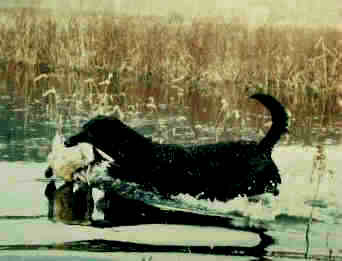| 10-21-02
It won't be like the good ol' days of waterfowling, but seasons on ducks
will open the length and breadth of Hoosierland on Saturday, October 26.
In the north zone (roughly the northern third of the state), the season
will open for both ducks and geese. This, the general waterfowl season
for the north zone, will remain open through December 21. These dates will
also apply to the Southern James Bay Population zone, six counties within
the north zone, an area where regulations on Canada geese in most years
differ from the rest of the zone. [Click
here to see the Indiana Waterfowl Hunting Zone
Map.]
The south zone season, which extends only through November 1, will be
for ducks only. A later season in this zone will open December 7 and continue
through January 31 for geese. Dates for the general season on ducks will
be November 23 - January 14.
In the Ohio River zone the early season for ducks only will continue
only through Sunday, October 27. The second part of the Ohio River zone
on ducks will open November 23 and continue through January 19. The season
on geese will open December 3 and continue through January 31. Unlike seasons
on geese in the last few years, there will be no quota on honkers in Posey
County or Hovey Lake SFWA.
The statewide season on snow geese opened October 20 and will continue
through January 31. It is of little consequence to Hoosiers because few
snows come our way when they head south.
The October 16 weekly waterfowl survey of the Division of Fish and Wildlife
(DFW) indicates some action in the migration of ducks, but because of low
water conditions many of the birds could bypass Indiana.
As a waterfowler might suspect, the bulk of the birds were on the eight
northern census areas where a total of 2,100 mallards and 1,300 woodies
were tallied.
Also as a waterfowler would suspect, Kankakee State Fish and Wildlife
Area (on the Starke/Pulaski, county line), and Willow Slough SFW (Newton
County) were leading the pack as hosts for mallards and woodies. Kankakee
had 1,000 mallards and 250 woodies, while the Slough's figures were 500
and 350, respectively.
There was no report on Lasalle SFW Area in the north but as of Monday,
October 20, this state line property was hosting roughly 200 mallards and
300 woodrows. Other northern properties showing fair numbers of birds in
the latest survey included Jasper-Pulaski Area on that county line, 300
mallards and 400 woodies, and Pigeon River (Lagrange County), 150 and 200.
Of course, all of the census properties were hosting some ducks, and
it is important to remember that the weekly survey's purpose is to monitor
the migration, not determine total duck numbers in the state.
The October 16 weekly survey showed roughly 600 mallards and 700
woodies on the 14 southern areas involved. Leaders were Patoka Reservoir
(Dubois County, Muscatatuck National Wildlife Refuge, Monroe Reservoir
(Monroe County east of Bloomington), and Mississinewa Reservoir (Miami
County east of Peru).
But here again, all of the areas involved reported some birds. Who knows
what a hunter might find if he looks for his own hunting areas.
For example, a couple of years back I noted huge flights of mallards,
woodies and other species pitching in on a farm pond 200 yards from my
deer stand. When my buck was safely in the freezer, I changed barrels and
ammo and helped myself to several daily limits of ducks.
Ducks then, are where you find them. And you can say the same for Canada
honkers, which are well represented in all Hoosier counties by good flocks
of resident birds. They never leave Hoosierland unless heavy snow forces
a southward move.
As this column, and its web page counterpart (www.bayoubill.com) has
pointed out, some of the best hunting for any species of wild game and
birds will be found on private land. Sure, the state properties offer a
good hunting opportunity, but these areas can get so crowded that a reservation
system is required. This means some hunters are turned away.
Still, many of the properties that offer reserved hunting have some
hunting areas that are not reserved and others have special drawings for
the hunting sites not claimed by no-shows (those who have a reservation
but do not show up for the hunt).
Hunters bent on trying one of the properties of the Department of Natural
Resources (DNR) will do well to check by telephone to get more details
on the area they wish to hunt. Phone numbers for state fish and wildlife
areas are available by calling the DFW (317-232-4080). There is also a
toll-free telephone number to call for information on all state properties
(including the reservoirs). It is 1-877-463-6367.
Top northern state-owned or managed areas for hunting ducks last year
were Kankakee, 4,316; Willow Slough, 3,299; and LaSalle, 1,900. Tops in
the south were Atterbury, 1,070; Patoka Reservoir, 712; Monroe, 682; Brookville
Reservoir, 501; and Minnehaha SFWA, 409.
Biologists of the DFW point out that this year's waterfowl hunting could
be rather slow because many of the migrating birds may fly over because
of low water levels at places that usually draw in migrating birds.
But we still have a lot of mallards and wood ducks that were hatched
here.
| This
black Lab retriever enjoys his work at Monroe Reservoir's Stillwater Marsh. |
 |
|

